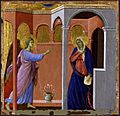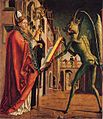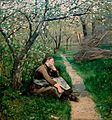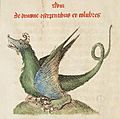Green facts for kids
| This box shows the color green. |
|---|
Green is a color that you see everywhere! It's one of the amazing colors in a rainbow, appearing right between yellow and blue. If you've ever mixed paints, you know you can make green by combining yellow and blue.
Green light, just like all light, is made of tiny energy packets called photons. The wavelength of green light is about 550 nanometers. That's one-billionth of a meter – super tiny!
Most leaves on growing plants, like trees and bushes, are green. This is because of a special chemical inside them called chlorophyll. Chlorophyll is what gives plants their green color and helps them make their own food using sunlight.
Contents
What Makes Green Light?
Green light is part of the electromagnetic spectrum. Our eyes see different colors based on the wavelength of light. Green light has a wavelength of about 550 nanometers. When light hits an object, some colors are absorbed, and some are reflected. If an object looks green, it means it's reflecting green light back to your eyes.
Green in Nature
Green is the most common color in nature, especially in plants.
- Plants: As mentioned, chlorophyll in plant cells makes them green. This is super important for photosynthesis, the process where plants turn sunlight into energy.
- Animals: Many animals are green, like some frogs, snakes (like the green mamba), and parrots. This color helps them camouflage themselves, blending in with leaves and grass to hide from predators or sneak up on prey. Some insects and spiders are also green, like the green huntsman spider.
- Eyes: Some people have green eyes! This happens because of a mix of light scattering and a small amount of a yellow pigment called lipochrome.
Green in Culture and Symbols
Green has many different meanings around the world.
- Luck: In many Western cultures, green is often linked to luck, especially with symbols like the four-leaf clover.
- Nature and Environment: Because it's the color of plants, green often represents nature, growth, and environmental movements.
- Safety and Permission: A green light usually means "go" or "safe," like on a traffic light.
- Money: The United States one-dollar bill is green, which is why American money is often called "greenbacks."
- Holidays: Green is a very important color for St. Patrick's Day, when the Chicago River is even dyed green!
- Sports: In sports like judo, a green belt shows a certain level of skill. Many sports teams also use green as their main color.
Green in Art and History
Artists have used green for centuries, but the way they made and used green pigments has changed over time.
- Ancient Times: In ancient Egypt, the god Osiris, who represented rebirth, was often shown with a green face. Ancient Roman frescoes also used green to show nature and spring.
- Middle Ages and Renaissance: In medieval art, green could sometimes be linked to the Devil or evil. However, it also showed wealth, as seen in the rich green fabric in famous paintings like the Arnolfini Portrait by Jan van Eyck.
- Later Art: Artists like John Constable and Jean-Baptiste-Camille Corot in the 18th and 19th centuries loved to paint the vibrant green landscapes of England and France. Later, Vincent van Gogh used green in his painting The Night Café to show strong emotions.
Related pages
- List of colors
- Chartreuse green
- Emerald green
- Erin
- Harlequin green
- Lime green
- Olive green
- Spring green
- Viridian
Images for kids
-
The Chicago River is dyed green every year to mark St. Patrick's Day
-
A green mamba
-
The chloroplasts of plant cells contain a high concentration of chlorophyll, making them appear green.
-
Frogs often appear green because dermal iridophores reflect blue light through a yellow upperlayer, filtering the light to be primarily green.
-
A yellow-naped Amazon parrot, colored green for camouflage in the jungle
-
The green huntsman spider is green due to the presence of bilin pigments in the spider's hemolymph and tissue fluids
-
The Ancient Egyptian god Osiris, ruler of the underworld and of rebirth and regeneration, was typically shown with a green face. (Tomb of Nefertari, 1295–1253 BC)
-
In the Arnolfini portrait by Jan van Eyck (1434), the rich green fabric of the dress showed the wealth and status of the family.
-
Duccio di Buoninsegna painted the faces in this painting (1308–1311) with an undercoat of green earth pigment. The surface pink has faded, making the faces look green today.
-
The green costume of the Mona Lisa shows she was from the gentry, not from the nobility.
-
In the 15th century Saint Wolfgang and the Devil by Michael Pacher, the Devil is green. Poets such as Chaucer also drew connections between the color green and the devil.
-
In this 1503 painting by Perugino, malachite pigment was used to paint the bright green garments of the worshippers, while the background greens were painted in green earth pigments.
-
Dedham Vale (1802) by John Constable. The paintings of Constable romanticized the vivid green landscapes of England
-
In the painting of Jean-Baptiste Debret (1822), Emperor Pedro I of Brazil wearing the imperial mantle decorated with green fabric.
-
In the paintings of Jean-Baptiste-Camille Corot (1796–1875), the green of trees and nature became the central element of the painting, with the people secondary
-
Spring, by Marie Bashkirtseff, 1884
-
The Night Café, (1888), by Vincent van Gogh, used red and green to express what Van Gogh called "the terrible human passions."
-
Louis Anquetin – Woman at the Champs-Élysées by night
-
Saint Wolfgang and the Devil, by Michael Pacher.
-
A 20th-century depiction of a leprechaun
-
The green benches in the House of Commons of the United Kingdom
-
The reverse of the United States one-dollar bill has been green since 1861, giving it the popular name greenback.
-
A green belt in judo.
-
A baccarat palette and cards on a casino gambling table.
-
A 1929 Bentley colored British racing green.
-
A billiards table, colored green after the lawns where the ancestors of the game were originally played.
See also
 In Spanish: Verde para niños
In Spanish: Verde para niños





































